
Marketing automation is exploding. Nearly every business–B2B or B2C, big or small–uses some form of marketing automation. Consider the following statistics, which act as a real eye-opener for the increasing popularity of marketing automation software:
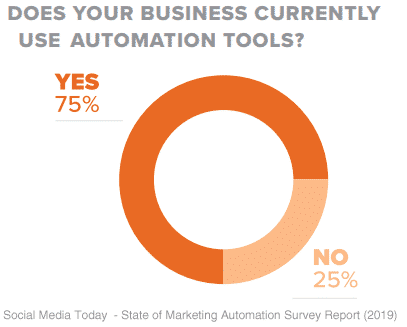
Clearly, the industry holds this type of software in high regard. But what is this technology, and how can it help B2B marketers achieve long-term growth? Keep reading.
First things first, let’s understand what marketing automation means and what it can be used for in the B2B space. Simply put, marketing automation includes software platforms and tools that allow marketers to effectively market their product/service on diverse digital channels, such as social media, email, website, etc. Additionally, it allows organizations to increase efficiency while decreasing costs as you can automate time-consuming and resource-intensive manual tasks, such as lead qualification, social media posting, etc. At this point, you might be wondering:
“What processes can marketers automate, and which elements still need a ‘human touch’?”
Good question.
There are a fair number of marketing processes that can be automated and require a “human touch” simultaneously for it to be effective. These include:
Creating personalized customer experiences by storing and analyzing real-time user-centric data via automation software. In fact, data indicates that 48% of marketers use marketing automation to deliver personalized customer experiences:
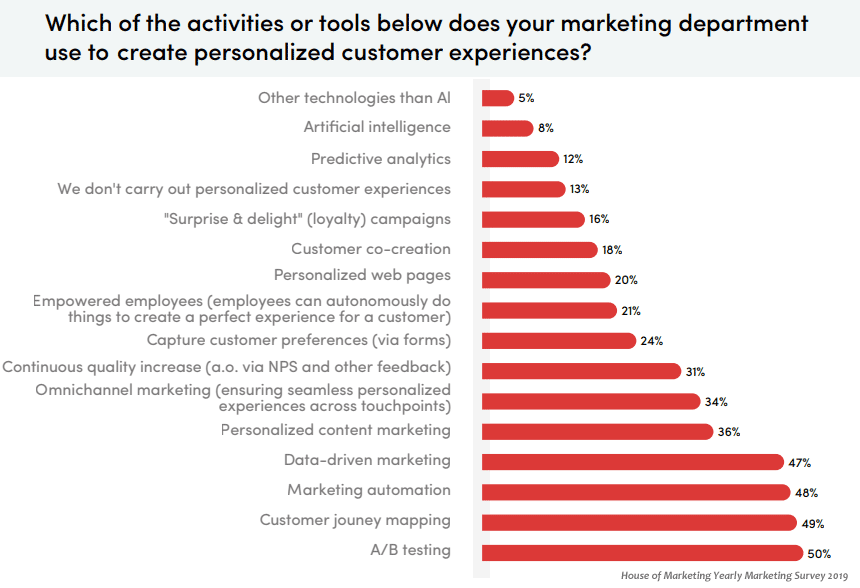
Human touch: Having accurate and reliable data at hand is of no use if marketers are not going to act on it. The insightful data that the software provides can be used by agents to deepen their customer relationships and strategize on ways to improve their customer’s experience.
Rolling out hyper-personalized and targeted email campaigns, with over 55% of e-commerce marketers using software for email marketing automation. With these softwares, it becomes super easy for marketers to send targeted welcome emails by connecting their ecommerce platforms like Shopify to Mailchimp or other email automation tools.
Human touch: Marketers need to constantly ensure that their email list is updated. This includes understanding which users are no longer active or which ones need specialized attention. While your software might do the heavy work of segregating your contacts & sending targeted email campaigns, the process of strategizing your email campaigns rests on the eyes, experience, and intuition of a seasoned marketer.
Mapping customer experience (53%) and driving personalized/dynamic content (51%) are also common use cases of marketing automation:
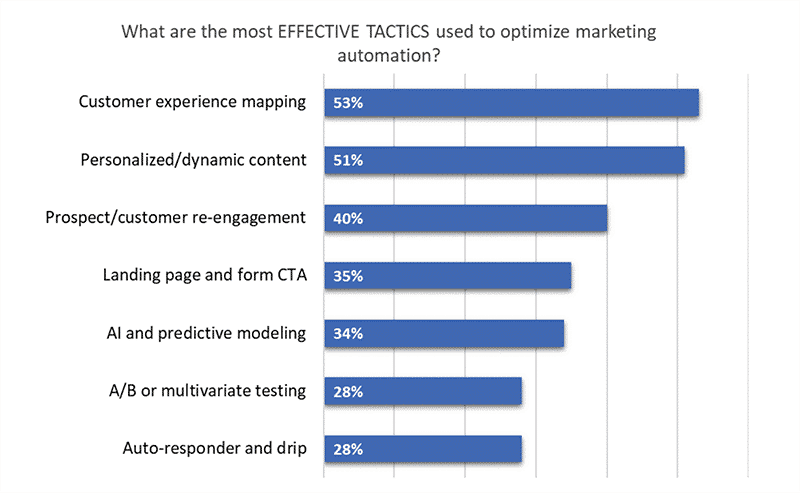
Human touch: Before you use marketing automation to map your customer journey, you will need marketers to establish best-practices with respect to sales processes, CX efforts, etc.
Automating the lead generation process, nurturing leads, and engaging in lead scoring are important applications of using marketing automation. Your software will segregate the potential leads from the lost customers effectively.
Human touch: You will need your human agents to complete the purchase and nudge prospects to become lifelong customers through deeper and customized experiences.
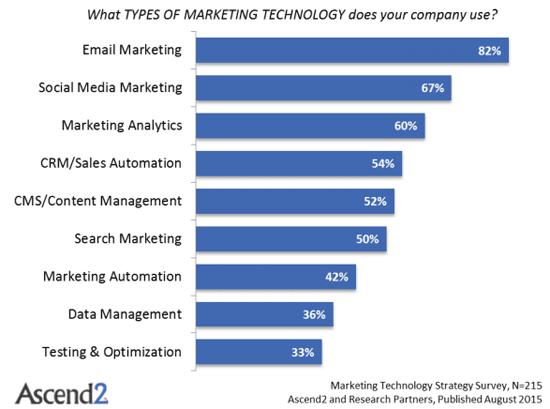
Key takeaway: Marketing automation allows B2B companies to scale their end-to-end marketing efforts with greater efficiency and optimization. Plus, they are ideal for automating repetitive tasks. However, these intelligent tools cannot replace the human-driven processes in marketing, such as driving greater intimacy levels with customers, strategizing on campaigns, problem-solving issues, or cultivating sustainable customer relationships. So to make the most out of your marketing efforts, it is important that you use both elements in a healthy balance.
Finally, let’s address why marketing automation is gaining traction and what its benefits are.
According to research, marketing automation allows marketers to engage in effective message targeting and, in turn, improve the customer experience:
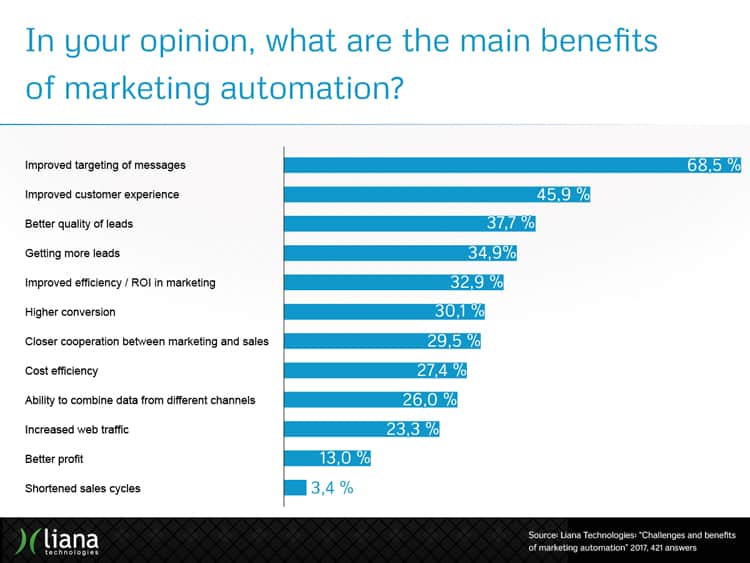
Another report states that marketing softwares boost productivity for around 43% of marketers:
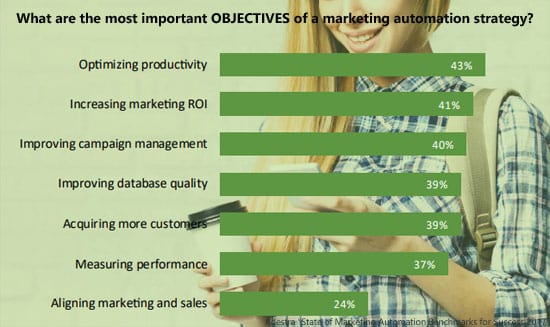
Since marketers are armed with real-time customer data, they can track user behavior and make tweaks to the marketing campaigns to personalize the experience and boost customer engagement.
All these efforts collectively contribute to a happier customer experience and increased loyalty towards the brand, thereby reducing the churn rate:
As a result of end-to-end automation, marketers can save valuable time on driving repetitive tasks and engage in processes that require creative and strategic thinking:
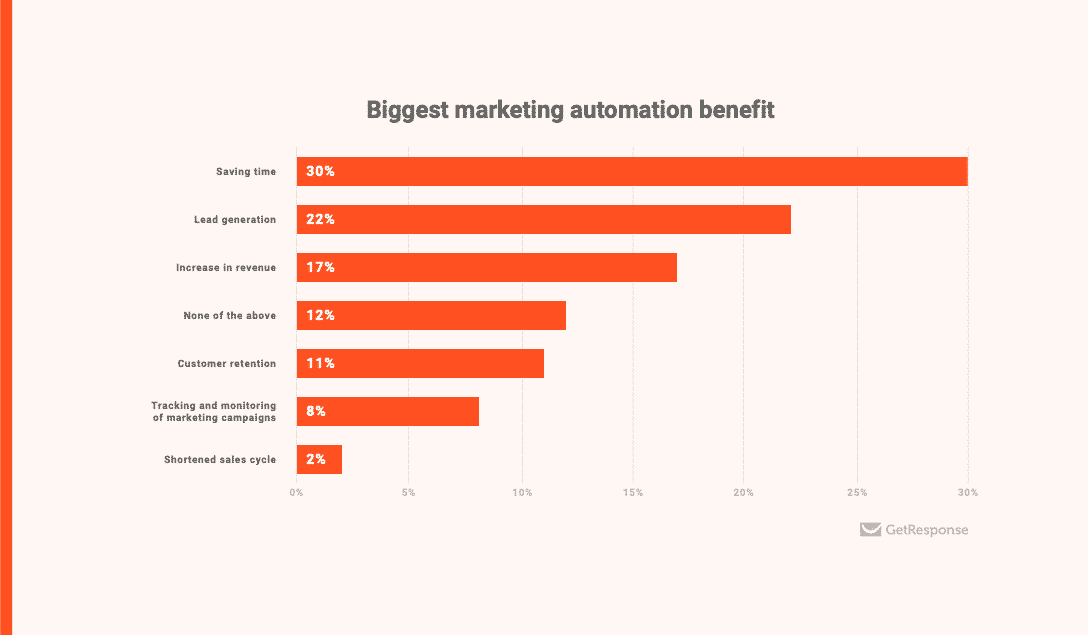
Now that you have a solid understanding of how B2B marketing automation can serve as a boon for your business, let’s look at the top-4 marketing techniques you can embrace to start your marketing efforts on the right track.
Much like your exit intent pop-ups, lead flow pop-ups placed strategically allow marketers to boost subscribers and, by extension, sales. Here’s an example of a lead generation pop up that captures user attention and encourages them to provide their email address in exchange for access to rich and relatable content of real value:
Here’s another example of a lead flow pop-up that offers high-value content (content marketing blog posts in this case) in exchange for the user’s email address:
Key takeaway: As long as you are offering your visitors valuable content (think: broadcast a webinar, downloadable white papers, informative ebook/guide, etc.), you will be able to capture high-quality leads and build your mail list.
Pro tip: You can start with a site-wide pop-up and then narrow it down to specific pages where you are finding high visitor interaction and activity.
Drip campaigns are most effective when used in moderation and in a logical sequence. To that end, here are the top best practices to keep in mind:
Here’s an example of a B2B marketing automation drip campaign by Salesforce:
Main goal: Capture the user’s attention before the trial expires.
Mail number 1: The first email gently nudges the user to get back to the product. The tone is friendly and casual:
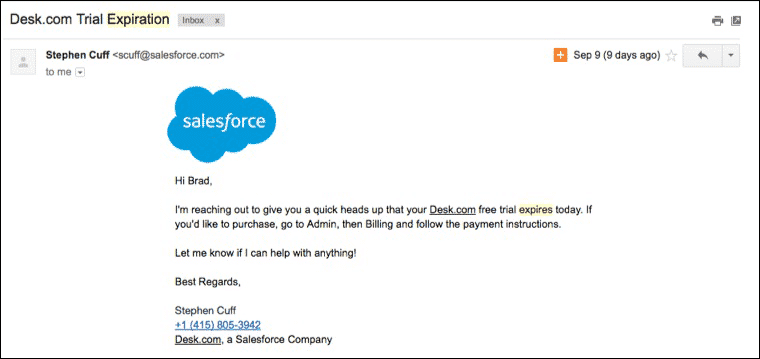
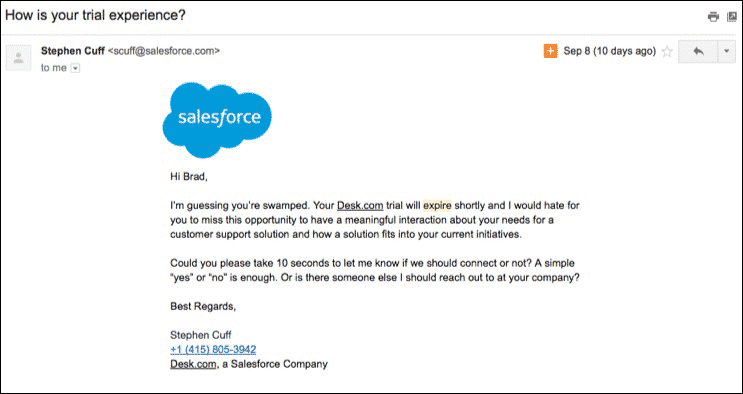
Mail number 2: It switches from soft-selling to hard-selling, encouraging users to subscribe to a plan. A compelling subject line and the insertion of a call-to-action button allows users to understand how to proceed next:
Mail number 3: This re-engagement email throws light on important information such as the fact that the user’s trial has expired and talks about what data is still saved. Similar to the previous email, this one too has a compelling subject line and call-to-action (“Subscribe Today”) to help reel the user in:
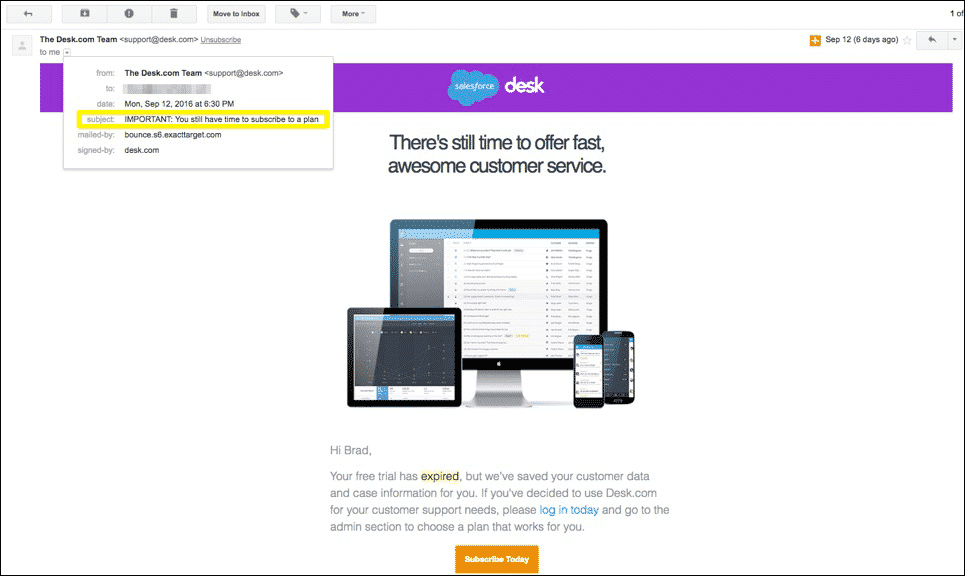
Key takeaway: Drip campaigns are an extremely effective way of keeping your customers engaged throughout the customer journey while boosting customer happiness and satisfaction. They serve as a window of opportunity to keep your customers informed and entertained of the brand’s offerings as well as new updates.
Your B2B customers today don’t mind helping themselves out if they can. In other words, empowering customers with the right kind of self-service support can allow your company to provide efficient, competent, and quick customer service. So what can you do to cater to your customer’s high-touch and dynamic demands in real-time? Simple, Include chatbot while crafting your customer service strategy.
When it comes to using a chatbot for customer support (Acquire and Zendesk are both great options), you can integrate it with a useful and in-depth knowledge base, complete with frequently asked questions (FAQs), important documentation, how-to guides, video tutorials, etc. As shown in the image below:
Key takeaway: Chatbots act as a handy virtual agent that can answer customer queries 24x7x365. They can be trained to provide accurate and relevant information at the click of a button and cater to your customer’s queries on the fly.
Lead nurturing campaigns are perfect for marketers who wish to target leads that have gone cold. One time-tested way of re-engaging them would be through a series of segmented and automated email marketing campaigns.
The other way is to engage them in Account-Based Marketing – or ABM it is commonly known – and target specific accounts using automation tools within a market. These types of segmented campaigns use increased personalization in emails and ads to cater to the user’s needs and drive the (marketing) message home. The end-goal is to relate to your targetted prospect’s leads to the extent possible. Here’s an example of an ABM campaign by Engagio that uses LinkedIn, RollWorks, etc. to target the Director of Marketing (and above) for specific accounts who have not been active for the last 30 days:
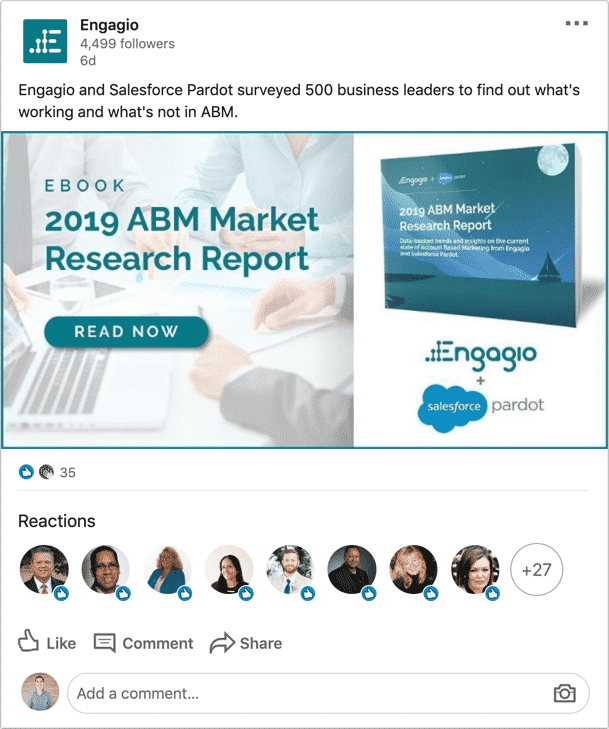
The campaign launched ABM ads to track engagement and follow-up with accounts that reach the “Marketing Qualified” level. The end result? It ended up driving 27% more awareness at the target account-level. This is an example of a One-to-Many ABM campaign that’s personalized at scale.
Key takeaway: Automated ABM campaigns allow brands to target specific sections of their user base with greater attention to detail and efficiency. This helps boost the lead generation rates as more and more users are seen engaging with customized content.
The B2B space, like B2C, is ever-evolving, and so are its customers. Marketers need to leverage the power of intuitive social marketing automation tools to capture quality leads, boost user experience through targeted and personalized marketing, and enhance their customer experience. Additionally, they also need to re-align and rethink how their team and valuable resources can make the most out of these tools and move ahead with a B2B strategy that keeps the team happy and the customers happier.
—
Author Bio:
Savan Kharod is a Digital Marketing Professional at Acquire. He loves to share his knowledge and experience in digital marketing, social media marketing, customer service, and growth marketing. In his free time, Savan likes to backpack and explore new places. You can reach out to him on LinkedIn or Twitter.